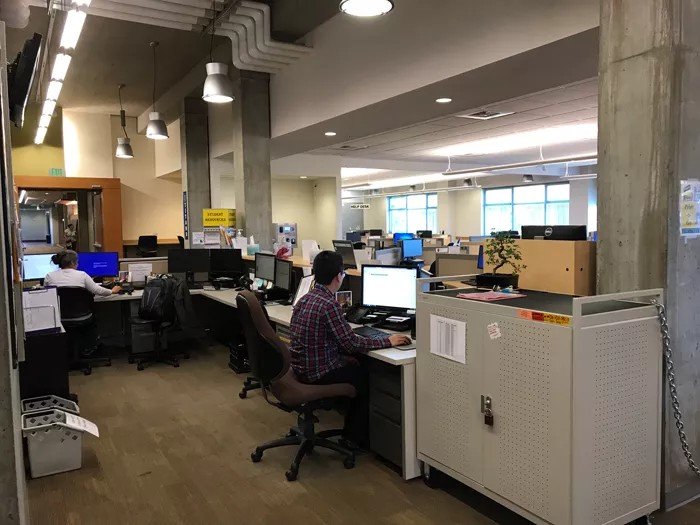Climbing the Accessibility Leaderboard
with Debra Padden and Christopher Soran, Tacoma Community College
College context: Accessible and Affordable for All
Nestled on the Puget Sound in the state of Washington, Tacoma Community College (TCC) serves over 11,000 students annually. We offer a range of degree based programs, continuing education opportunities, and over 30 vocational and technical programs. In support of TCC’s Strategic Vision for more equitable and inclusive learning environments, our eLearning Office prioritizes the use of accessible, affordable digital content. Through our help desk, Instructional Designer & Open Educational Resources (OER) coordinator, and multimedia team, we aim to provide students and professors with innovative learning tools and high-quality support.
Goals for Ally: Options for Engagement
Prior to Ally, our eLearning offerings included several digital tools that gave students some increased choice and flexibility in how they engaged with their course content, such as the option to listen to text. We found not only did students with disclosed disabilities benefit from using these kinds of tools, so too did many English Language Learners and commuter students. Yet we also felt there were some gaps in functionality with our existing toolset that limited their potential impact on accessibility and student success. With Ally, we saw a product that could both enhance student access to a greater variety of alternative formats downloaded direct from course files or modules, and increase professor awareness about the value of accessible content for all students.
With Ally, we saw a product that could both enhance student access to a greater variety of alternative formats direct from course files, and increase professor awareness about the value of accessible content for all students.When we inquired about Ally, we discovered the Washington State Board (SBCTC) was also looking at adopting Ally for their 34 community and technical colleges as part of a state-wide commitment to the 2016 Accessible Technology Policy. With accessibility becoming more of a priority, we saw Ally as a tool to spark the conversation with professors about the importance of accessible, open content, and for our eLearning office to take some strategic steps to support faculty in making their courses more inclusive.

Implementation Strategy: Gamifying Accessibility
To organize our course review process and help professors keep track of their accessibility improvements, we designed an accessibility checklist. The list included formatting of HTML content, formatting the syllabus, adding captions to video content, and checking the accessibility of course files and documents using Ally. In an effort to help professors with their content, we used Ally to train our eLearning staff on how to correct issues, since some had limited experience with accessible document authoring. Leading up to our campus-wide roll-out of Ally, we posted announcements on the front-page of our Canvas environment, sent email blasts, and introduced Ally at workshops.
We also wanted to incentivize our professors to participate and bring some fun to our accessibility initiative, so we thought, “Let’s gamify it!”We also wanted to incentivize our professors to participate and bring some fun to our accessibility initiative, so we thought, “Let’s gamify it!” We assigned point values to each of the checklist itemslike 25 points for having an accessible syllabus, 25 points for captioning all videos in the course, or 100 points for having a completely accessible course. [See "Gamification Structure" for full list] We awarded professors prizes when they reached certain point totals, and even created a campus leaderboard that displayed professors’ total points to inspire some friendly competition.

Evaluation and Findings: Motivated Professors Make Improvements
Through a collaborative, committed effort across our campus, our institutional report shows our overall accessibility score increased 31 points in a single month with the help of Ally!
When we rolled-out Ally to the campus, professors responded positively to the indicators, which allowed them for the first time to see a detailed view of their file accessibility. The indicators prompted professors to seek out help from our office with issues they couldn’t solve on their own, and we were able to accommodate those requests because of our staff trainings and the time saved with the Ally feedback and reporting. We also found professors generally enjoyed and were motivated by the leaderboard and prizes, which we were able to moderate using Ally to determine if professors no longer had any red or orange indicators next to their active course files.
Ally has quickly become integral to how professors design their courses, and how our eLearning office supports them when they need assistance. By helping spur the accessibility conversation between our eLearning teams and professors, we’ve even been able to use Ally to support our OER initiative by encouraging professors to exchange their inaccessible copyrighted content with accessible OER content and linking to accessible library database resources. Through a collaborative, committed effort across our campus, our institutional report shows our overall accessibility score increased 31 points in a single month with the help of Ally!
Pearls of Wisdom: Focus on Student Impact, Make it Fun
Although legal requirements and state policies can drive campuses to take action, the pathway to inclusion doesn’t have to be scary or uncertain for professors. Focusing on the myriad ways accessible content can benefit all students- such as in making courses more mobile friendly for students who may not have consistent access to a computer- can help professors recognize the value of accessible content to student success, and can inspire them to take a more proactive approach to making improvements. Combining a tool like Ally with the proper support structures while infusing some fun into the process, we can motivate and empower professors to make inclusive design a priority in their teaching.







 Ally 사용자 그룹에 참여
Ally 사용자 그룹에 참여